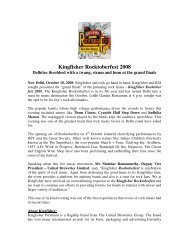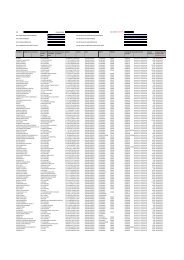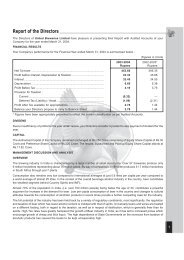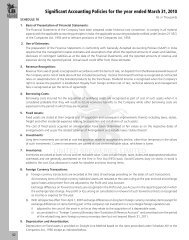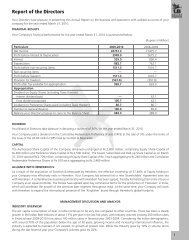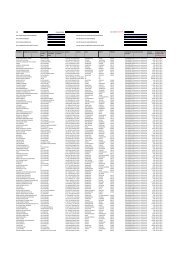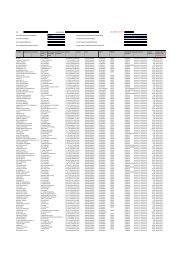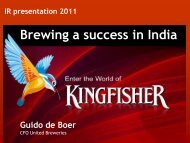Annual Report 2011 - 2012 - United Breweries Limited
Annual Report 2011 - 2012 - United Breweries Limited
Annual Report 2011 - 2012 - United Breweries Limited
Create successful ePaper yourself
Turn your PDF publications into a flip-book with our unique Google optimized e-Paper software.
Notes to Consolidated Financial Statements (contd.)<br />
(All amounts in Rs.lacs, unless otherwise stated)<br />
Contributions to the Employees’ Provident Fund, Superannuation Fund, Employees’ State Insurance and<br />
Employees’ Pension Scheme are as per statute and are recognised as expenses during the period in which the<br />
employees perform the services.<br />
ii) Defined-benefit plans:<br />
Provident fund: In respect of certain employees, Provident Fund contributions are made to a Trust administered<br />
by the Company. The Company’s liability is actuarially determined (using the Projected Unit Credit method)<br />
at the end of the year and any shortfall in the fund size maintained by the Trust set up by the Company is<br />
additionally provided for. Actuarial losses / gains are recognised in the Statement of Profit and Loss in the year in<br />
which they arise.<br />
Gratuity: Liability towards gratuity is determined on actuarial valuation using the Projected Unit Credit Method<br />
at the balance sheet date. Actuarial Gains and Losses are recognised immediately in the Statement of Profit<br />
and Loss.<br />
iii) Other long term employee benefits:<br />
Liability towards leave encashment and compensated absences is recognised at the present value based on<br />
actuarial valuation at each balance sheet date.<br />
iv) Short term employee benefits:<br />
Undiscounted amount of liability towards earned leave, compensated absences, performance incentives etc. is<br />
recognised during the period when the employee renders the services.<br />
74<br />
2.13 Taxation:<br />
Current tax is determined as per the provisions of the Income Tax Act, 1961<br />
i) Provision for current tax is made, based on the tax payable under the Income Tax Act, 1961. Minimum Alternative<br />
Tax (MAT) credit, which is equal to the excess of MAT (calculated in accordance with the provisions of section<br />
115JB of the Income Tax Act,1961) over normal income-tax is recognized as an asset by crediting the Statment<br />
of Profit and Loss only when and to the extent there is convincing evidence that the Company will be able to<br />
avail the said credit against normal tax payable during the period of ten succeeding assessment years.<br />
ii) Deferred tax is recognised, on timing differences, being the difference between taxable income and accounting<br />
income that originate in one period and are capable of reversal in one or more subsequent periods. Deferred tax<br />
assets are not recognised unless there is virtual certainty that sufficient future taxable income will be available<br />
against which such deferred tax assets can be realised.<br />
2.14 Earnings per share:<br />
<strong>Annual</strong>ised earnings /(loss) per equity share (basic and diluted) is arrived at based on ratio of profit /(loss) attributable<br />
to equity shareholders to the weighted average number of equity shares.<br />
2.15 Impairment of Assets:<br />
At each Balance Sheet date, the Company assesses whether there is any indication that assets may be impaired.<br />
If any such indication exists, the Company estimates the recoverable amount. If the carrying amount of the assets<br />
exceeds its recoverable amount, an impairment loss is recognised in the accounts to the extent the carrying amount<br />
exceeds the recoverable amount.<br />
2.16 Provisions, Contingent Liabilities and Contingent Assets:<br />
Provisions are recognised when the company has a present obligation as a result of past events, for which it is<br />
probable that an outflow of resources embodying economic benefits will be required to settle the obligation and a<br />
reliable estimate of the amount can be made. Provisions are reviewed regularly and are adjusted where necessary<br />
to reflect the current best estimates of the obligation. When the company expects a provision to be reimbursed,<br />
the reimbursement is recognised as a separate asset, only when such reimbursement is virtually certain.<br />
A disclosure for contingent liability is made where there is a possible obligation or present obligation that may<br />
probably not require an outflow of resources.<br />
2.17 Leases<br />
Leases in which a significant portion of the risks and rewards of ownership are retained by the lessor are classified<br />
as operating leases. Payments made under operating leases are charged to the Statement of Profit and Loss on a<br />
straight-line basis over the period of the lease.




